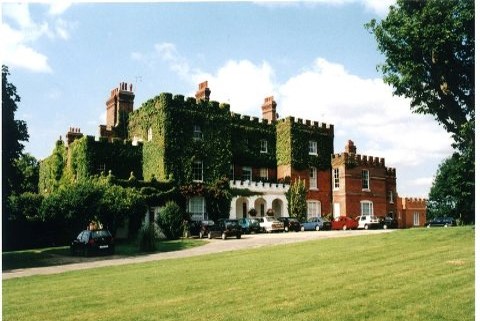Emma Susannah Blyth, born eight years into the new queen’s reign – Victoria, that is – was a pupil at the School between 1853 and 1860. This was because her father, James Blyth, died in 1852 at the age of 48. He had been a greengrocer and cheesemonger and in 1851, the last census in which he appears, his residence was Nutford Place, Marylebone. Although this street still exists, it has all been redeveloped and none of the mid-nineteenth century housing stock is evident. Born in Norfolk, James married Caroline Gilbey in 1839 and they took up residence in Chelmsford where Emma was baptised in what was then St Mary the Virgin and is now (from 1914) Chelmsford Cathedral.

Take note of the mother’s maiden name as that is going to become important.
At some point between 1847 (when the youngest child was born) and 1851, the Blyth family moved from Essex to Marylebone and for the next half century or so Emma Blyth claimed the capital as her home. Although Nutford Place was their residence in 1851, by 1853 James’ widow was given as residing at 27 Upper Southwick St, Hyde Park as a lodging housekeeper. Now there are lodging houses and there are lodging houses. This one was the superior kind inhabited by well-to-do gentlemen with society connections, as witness this record from the National Archives at Kew:

However, when Emma left school on 22nd March 1860, she was returned to her mother who was then at 36 Norfolk St, Strand so there appears to be a little instability in the Blyth residences during this period. Norfolk St was in an area once in the possession of the Howard family, the Dukes of Norfolk, and the streets were laid out after Arundel House was demolished in 1678. The image shows the junction between Howard St and Norfolk St so the family might be moving quite frequently but the houses were very grand.

Less than a year later, in the 1861 census, Caroline and her children are found in Great Titchfield Street. The return places them in ‘House in Yard’ but remember the Gilbey name? Caroline Blyth nee Gilbey’s brothers founded the company W & A Gilbey which created Gilbey’s Gin.

‘On the east side of the street, running back alongside All Saints’ Church, wine stores were erected in 1860–1 for the wine importers and distillers W. & A. Gilbey, whose business was expanding … Described as ‘cellars above ground’, these consisted of at least two floors of vaults for barrels, connected by a ramp, taking up three sides of a glass-roofed courtyard …’ https://www.ucl.ac.uk/bartlett/architecture/sites/bartlett/files/chapter23_great_titchfield_street.pdf
So the ‘house in the yard’ was a part of the Gilbey premises. ‘Relations were drawn in to run the new branches, so that it expanded as an interlinked family business from the start’ http://www.locallocalhistory.co.uk/industrial-history/drinks-trade/page1.htm
Emma’s brother James Blyth joined the firm. ‘James Blyth and Alfred Gilbey toured French and other Continental vineyards, buying and shipping direct to England for bottling at the Pantheon… ‘ (ibid)

James was ‘a recognised authority on wine culture and wine commerce’ and was created a Baronet of Chelmsford in 1895. In 1907, he was raised to the peerage as Baron Blyth of Blythwood and of Stanstead Mountfichet in the County of Essex.

Given the success of W & A Gilbey and the interconnection of the Blyth and Gilbey families, it hardly comes as a surprise to find that Emma never had any occupation recorded for her but she is found in various census returns at posh houses: 1871 and 1891, she was residing in Great Marlborough St, Westminster and in 1881 at Elsenham Hall in Essex. This was the home of Uncle Walter Gilbey (the W of W & A Gilbey)
Image from http://www.elsenham-history.co.uk/misc/miscdocs/Sir%20Walter%20Gilbey.%20Bart.%20.pdf and map from https://www.recordinguttlesfordhistory.org.uk/elsenham/elsenhamhistory.html
‘While Walter Gilbey lived at the hall, the Prince of Wales was a frequent visitor and on December 11th 1889, he also brought with him Sir Randolph Churchill and several other dignitaries.’ https://www.recordinguttlesfordhistory.org.uk/elsenham/elsenhamhistory.html
So no doubt during the time that Emma was there, she too moved in exalted circles. Elsenham Hall is now divided into flats but the exterior still looks much as it did.

Where Emma was in 1901 is a mystery as she is not found in any of the census returns. Clearly she was somewhere as she reappears in 1911 at Dormston, 41 The Avenue, Beckenham. This is given as a ten roomed property which Emma occupied with two servants, a cook and a housemaid. Also there at the time the census was taken were her nephew, Oscar Blyth Taylor, a decorative artist, and a visitor Claude Gothard, a stockbroker. The Avenue today is what an avenue was originally – a roadway with trees on either side. The houses are mostly large modern-built properties. There does not appear to be anything from early C20th so possibly the land was acquired, original properties demolished and newer houses built but all of a substantial size.
Emma died on 27 Oct 1927, her estate being valued at £3.5k [equivalent of £11,500 today) – not bad for someone who never apparently earned a living! Given that, on her father’s death, the family met the criterion of indigence, if Emma’s estate derives from family, it post-dates 1853. As the Gilbeys were clearly family-oriented, it seems not unreasonable to suppose that Emma’s income stemmed from them or their property. Like many other members of her family, Emma is buried in Bishops Stortford Old Cemetery, recorded on the headstone for her brother James.

The little girl born on 24 February 1845 who lost her father when she was seven years old – as did so many of the pupils – ended her days living in comfort and all because her uncles, at a loose end after returning from the Crimean war in 1856, started a wine merchant’s business which branched out.

Gin and tonic?
Don’t mind if I do!
